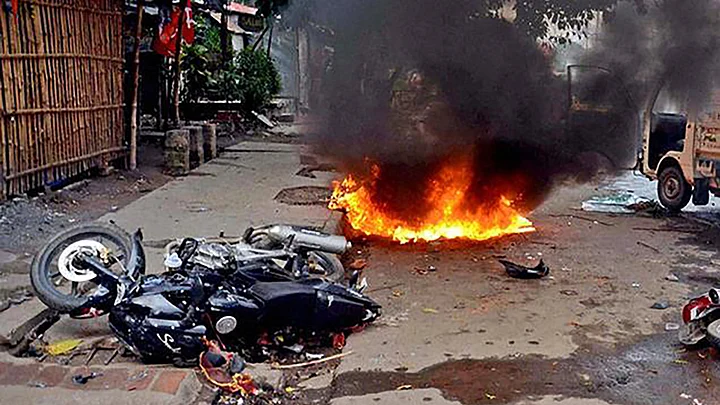You can listen to the story below
If you don’t live in West Bengal, chances are you don’t think of Bengalis as a violent people. Argumentative, pretentious and perhaps a bit too loquacious, but usually reluctant to use their fists.
When it comes to politics in West Bengal, though, violence seems to be the currency of choice for political parties. For years, the CPI(M) was accused of intimidating voters and Opposition cadres. This election cycle, Mamata Banerjee’s Trinamool Congress (TMC) has taken up the mantle with vigour. Every phase of polling has been accompanied by open attacks, either by “unknown persons” or TMC party workers.
So what is it about West Bengal that makes its politics so violent? Over casual conversations with politicians, political analysts and journalists in Kolkata, we were able to pick up three theories that try to explain political violence and the politics of violence in Bengal.
1. The Commie Theory: It’s an Attempt to Undo Land Redistribution
At Alimuddin Street, the iconic headquarters of the CPI(M) in Kolkata, veteran Communist leaders have (unsurprisingly) a Marxist and materialist explanation for political violence in West Bengal.
The root cause of violence is economic interest. Operation Barga, the Left Front’s land reform program in Bengal gave share-croppers protection from eviction and tillers the right to their land. It is often regarded as one of the most successful land redistribution programs in the country.
Land though, is an important economic asset and from this comes emotional, almost primordial ties. Land ceiling and redistribution was marked by violence. Now though, the CPI(M) believes, the violence is to help the erstwhile landlords. The TMC is trying to undo the pro-poor policies of the Left by trying to take back the land.
The proximate cause? Political parties are doing everything they can to hold on to or attain power.
2. The Naxals Did It
At the Press Club, a middle-aged, erudite looking (read nerdy) gentleman wasn’t blown away by Alimuddin Street’s formulation. The real reason for the state’s violence, according to the senior political analyst, is a bit more prosaic. The Naxal movement originates in Bengal, from Naxalbari, where it gets its name.
They advocated violence against landlords and in 1971, one of the founding fathers of Naxalism, Charu Mazumdar advocated the “annihilation line” i.e. assassination of individual “class enemies”. Most leaders of the Naxal movements had been CPI(M) members and their former party was opposed to their program. There was conflict between the Naxals and the parliamentary communists, and it was not limited to heated debate.
It was this period of Naxalism that made violence an essential feature of West Bengal’s politics.
3. Identity Politics Without Identity
Not all the explanations centred around the various kinds of Communists and their theories. For one of the most senior journalists in West Bengal, political ideology is to Bengalis what social identity is to neighbouring Bihar or Uttar Pradesh.
The politics of caste and religion hasn’t taken root here in the same way, but that doesn’t mean that politics doesn’t arouse passion. For the youth in Bengal, according to the journalist, political loyalties are as strong as any “social identity”. We all know the violence that has been done in India in the name of religion. Why should a more secular affiliation be any less dangerous?
